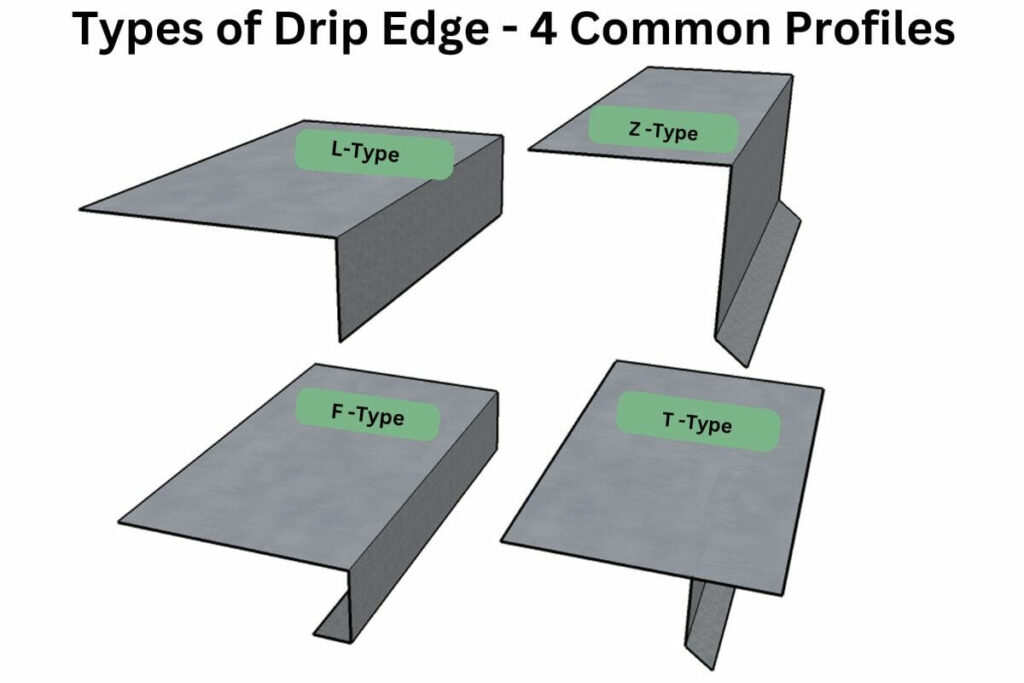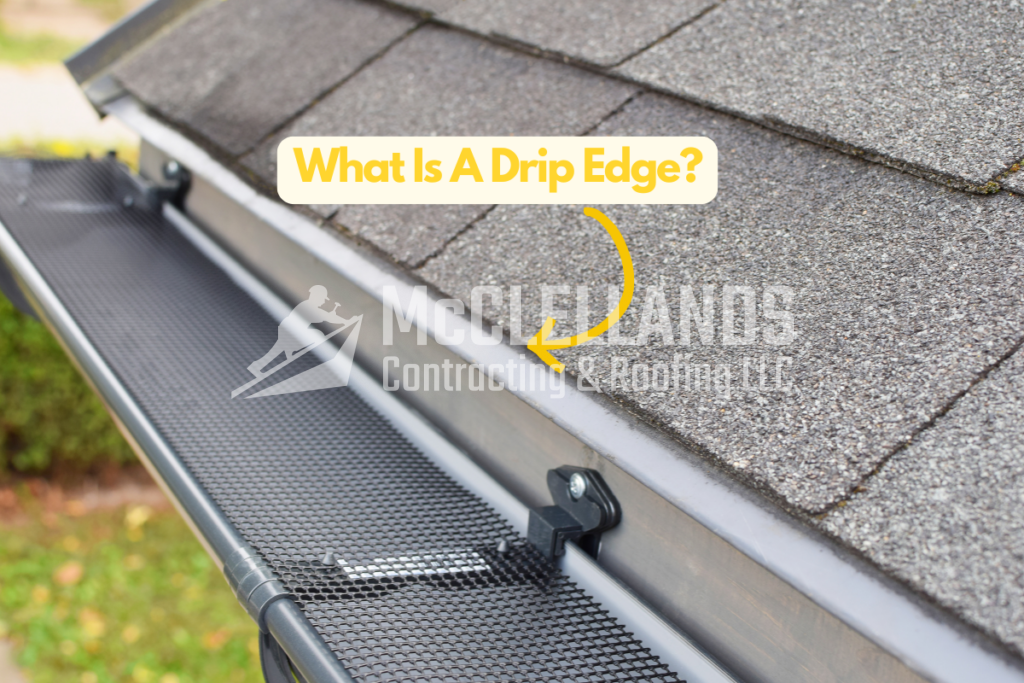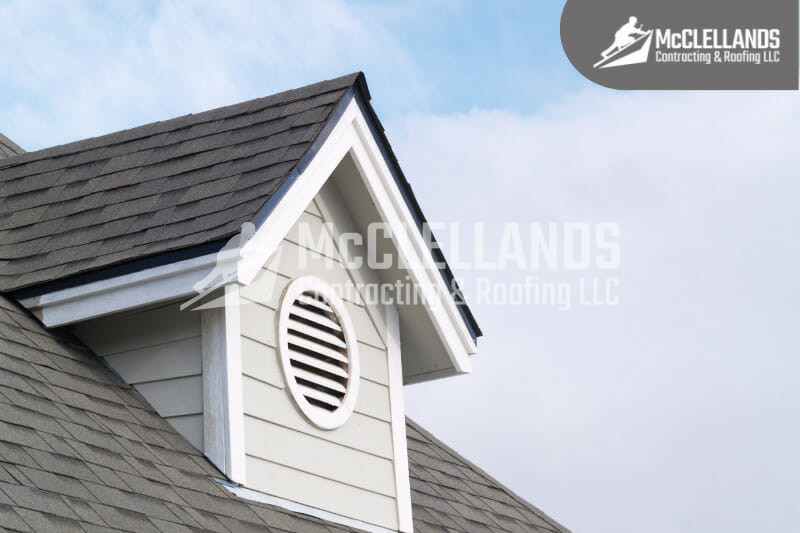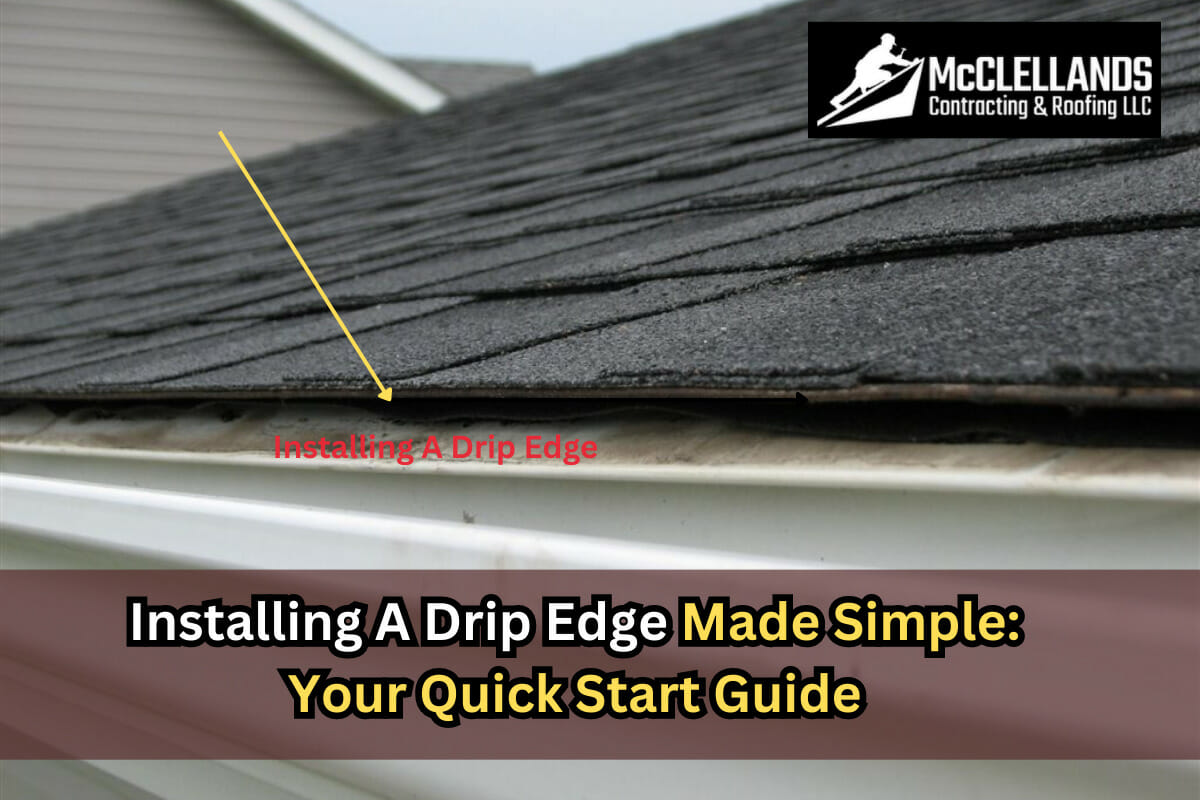A proper roof has several components. Homeowners often focus on the roofing material and ignore other aspects. Even small roof components play a crucial role in protecting against water damage and wear and tear.
If you want your roof to protect your home for ages, you need a drip edge flashing on your roof. As a seasoned roofing expert, I’m here to help you understand different types of drip edge flashing and guide you on choosing the right one for your roofing needs.
What Is A Drip Edge On Roof?
A drip edge is a piece of metal flashing installed along the edges of a roof, where the roof’s shingles or other roofing material meet the eaves and overhangs. A drip edge is typically installed under the roofing material, extends slightly over the edge of a roof, and includes a flange that bends away from the fascia. This creates a small gap between the roof and the edge of the building.
In the next section, we will discuss the topic further, what flashing does, and the advantages your home will have if you install quality drip edge flashing.
What Does Drip Edge Flashing Do?
The roof’s drip edge is an essential flashing component on a roofing system that helps protect the edges of the roof from water damage. It is installed along the eaves and rakes of a roof to guide water away from the fascia and prevent it from seeping into the underlying structure. It also protects the siding and porch from water damage by preventing rainwater overflow at the gutters.
Why Should You Install A Drip Edge For Your Roof?
You don’t want to install a component unless it offers to improve the condition of your roof and home. A roof’s drip edge protects the components of your roof from water damage and other harmful weather conditions.
Here are some of the advantages of a drip edge:
1. Effective Protection Against Water Damage
A drip edge along a roof offers great protection against water damage. It will keep water away from the edges, which is the most vulnerable part of a roof, and help prevent roof leaks and wood rot.
2. Prevents Ice Dam Formation
In addition to preventing water damage, a drip edge can also help prevent ice dams, which occur when ice builds up at the edge of a roof and prevents water from draining properly.
This may lead to significant water damage and is a common problem among homes in colder climates. However, with a properly installed drip edge, water is directed away from the roof, helping to prevent the formation of ice dams and the damage they can cause.
3. Can Act As A Fascia Guard For Your Roof
If you install a good quality drip edge along a roof, then you can also save your fascia from getting damaged, enabling the beautiful components to last longer.
Water can cause the fascia board to rot, weakening the roof structure and creating entry points for pests. By directing water away from the fascia board and into the gutters or off the roof’s edge, a drip edge helps prevent water from seeping into the fascia board, which can prolong the life of the board, and the roof’s structure.
4. Prevent Pest Infestation
One of the essential but lesser-known benefits of installing a drip edge is that it can prevent pests from entering and damaging your home. Without a drip edge, gaps can form between the roof decking and the fascia, creating entry points for insects, rodents, and other pests. Once inside, these pests can cause damage to your home and pose a health risk to your family.
Not only do they prevent pests, but drip edges prevent birds and other wildlife from nesting in a roof, which may also cause damage to roofing material like shingles, and pose a health risk to your family. A drip edge can help maintain a clean, healthy living environment and prevent costly pest control efforts by keeping pests out of your home,
5. Improve Your Roof’s Lifespan
In the advantages stated above, we have learned that installing a drip edge on the roof can help prevent water from running down beneath the shingles and causing damage to the decking.
A drip edge prolongs the roof’s life by preventing rot, mold growth, and other types of water damage that can lead to premature deterioration of a roof.
Types of Drip Edge Flashing
The material and profile of the flashing determine its durability and ability to divert water. Here are some of the most common drip edge shapes:

1. L-Type Drip Edge (Basic Shape)
The L-type drip edge is one of the most common profiles used in roofing. It features a horizontal flange that extends over the roof deck and a vertical flange that covers the fascia board. This design helps channel water away from the roof and prevents it from seeping into the underlying structure.
2. T-Type Drip Edge (Advanced Protection)
The T-type drip edge has a similar design to the L-type, but with an additional flange that extends under the roofing material. This provides an extra layer of protection against water intrusion and helps create a more watertight seal.
3. C-Type Drip Edge (For Metal Roofs)
The C-type drip edge is shaped like the letter C and is commonly used on metal roofing systems. It provides a smooth transition between the roofing material and the fascia, preventing water from penetrating the roof’s edge.
4. F-Type Drip Edge (For Windy Areas)
This type of drip edge is often used in areas with high wind exposure. The F-type drip edge is also known as a gutter apron, featuring an extended flange that overlaps the roof deck and the fascia board. It offers enhanced protection against wind-driven rain and helps prevent water from dripping behind the gutters.
5. Z-Type Drip Edge (For Steep Roofs)
The Z-type drip edge is named after its Z-shaped profile. It is commonly used in steep-slope roofs and provides excellent protection against water infiltration. The Z-shape design helps redirect water away from the fascia and onto the roof surface, ensuring effective drainage.
Materials Used to Make Roof Drip Edges
To make sure the drip edge remains protective for years, it’s crucial to choose a sturdy material. Here are some commonly used options:
Aluminum
Aluminum is a popular choice for roof flashing due to its durability, lightweight nature, and resistance to corrosion. It is easy to work with and can be painted to match the roof’s color scheme. Aluminum is suitable for many more roofing materials and can withstand harsh weather conditions, including saline atmospheres.
Galvanized Steel
Galvanized steel is known for its strength and longevity. The steel is coated with a layer of zinc, which provides protection against rust and corrosion. A galvanized steel drip edge is often used in areas with high moisture levels and is compatible with a wide range of roofing materials.
Copper
Copper drip edges offer both durability and an aesthetically pleasing appearance. It develops a natural patina over time that can add an element of charm to any roofline. Copper is resistant to corrosion and can withstand extreme weather conditions, making it an excellent choice for long-lasting protection.
Vinyl
A vinyl drip edge is a cost-effective option that is easy to install. It is lightweight, resistant to rust and corrosion, and requires minimal maintenance. Vinyl flashing comes in various colors, allowing homeowners to choose a shade that complements their roof’s design.
You should carefully evaluate these options based on your roof type and local climate. Let’s understand the factors that may affect how the drip edge protects your roof.
What Is The Cost Of A Drip Edge?
Installing a drip edge is an affordable way to prevent roofing problems. According to Angi, installing a drip edge costs $1 to $3 per linear foot. However, the cost varies by material. A high-end copper drip edge can cost $10-$15 per linear foot. Proper installation is crucial, as mistakes can lead to expensive repairs down the road. The key is finding an experienced contractor who can install a drip edge correctly.
Factors to Consider When Choosing Drip Edge Flashing
When selecting the right kind of drip edge material and profile, homeowners should consider several factors before making a choice.
Cost
Consider your budget when choosing a drip edge profile and material. Compare the prices of different brands online, weighing the benefits they provide against their cost. The cost to install a drip edge can vary depending on the project, so it’s best to get started with a free consultation offered by your local roofing contractor.
Climate and Weather Conditions
Consider the climate and weather patterns in your area. If you experience heavy rain, strong winds, or extreme temperatures, you will need a flashing material that can withstand these conditions without deteriorating.
Compatibility With The Roofing Material
Ensure that the chosen drip edge type is compatible with the roofing material you intend to use. Different materials may require specific types of drip edge profiles to ensure a proper fit and effective water diversion.
But it does not end with shopping for the right products and tools. The proper installation of drip edge flashing will finally ensure its effectiveness and durability. A good quality flashing material can easily be rendered useless if it has gaps or it damages adjoining roofing materials.
So if you need someone who can do everything right, our McClellands Contracting and Roofing team is here to help!
Free Roofing Consultations and Estimates for Pittsburgh Homeowners
At our company, we genuinely care about the well-being of your home and take pride in delivering reliable roof repair and replacement services for Pennsylvania homeowners. As part of the Pittsburgh community, we provide free consultations and estimates, ensuring that our neighbors have all the information necessary to make informed decisions.
When you choose us, you’re not just selecting a roofing company but a trusted local partner who will go above and beyond to exceed your expectations. Our team of experienced professionals will attentively listen to your concerns, assess your unique situation, and provide personalized recommendations to address any roofing issues you may be facing.
If you are looking for roof drip edge installation or a roof repair service in Pittsburgh, call us at (412) 353-5660. Let us help you get a durable roof that can stand the test of time.
FAQs
A. The two are no different, but drip edge flashing often describes the flashing materials used to make the drip edge, or the roofline flashing strip that directs water into the gutters.
A. Installing drip edge flashing requires certain tools and materials, as well as adherence to proper installation methods. Since it goes beneath the shingles, it also requires lifting and reinstalling those shingles. If you are confident and experienced with such roofing work, you can do it. But for major roof repairs or replacements, many local codes require you to have a license, as improper installation can cause damage to the roof, risking your home’s safety and voiding product warranties and insurance claims.
A. While it is not mandatory for all roofs, it is highly recommended as it provides an additional layer of protection against water damage. Moreover, many roofing codes mention that a drip edge is necessary to safeguard your roof’s integrity.





